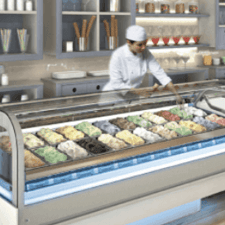What is the difference between Gelato V’s Ice Cream?
Many people don’t know the difference between Gelato and Ice Cream; how its made, ingredients, the taste and the texture. So we are going to answer all of these questions for you so that by the end of this article you will be an expert too and will fully understand the big question; Gelato V’s Ice Cream and which is best?
What is Gelato?
Gelato is the Italian word for ice cream. It starts with a similar custard base to ice cream, but has a higher proportion of milk and a lower proportion of cream and eggs, or sometimes no eggs at all. The ingredients are churned at a much slower rate than ice cream ingredients, which subsequently incorporates less air, leaving the gelato far denser than normal ice cream.
What is the difference between Gelato V’s Ice Cream?
Gelato is much denser than standard ice cream as the churning rate is slower, it incorporates less air into the mixture than ice cream does. This results in Gelato containing about 25 to 30 percent air, whilst ice cream can contain as much as 50 percent. Gelato has about 5-7% fat versus the must have 10% fat in ice cream, and this is because Gelato is made with a greater proportion of whole milk to cream. Gelato is stored and served at a slightly warmer temperature to ice cream so it’s not quite completely frozen which makes it soft, cream and dense whilst ice cream are served frozen so feel’s colder when eating it. Both Gelato and ice cream can be made into many different and exotic flavours to zing your taste buds. A lot of people find that the flavours are much more intense in Gelato and this is due to its lower fat content so it doesn’t coat the mouth and taste buds in the same way as ice cream does
One important fact that everyone should know is that whatever time of year it is, winter, spring, summer or autumn, both gelato and ice cream are an amazing and delicious treat and one that you won’t be able to resist.
What are the ingredients of Gelato?
Both gelato and ice cream contain cream, milk and sugar, however, authentic Gelato uses more milk and less cream than ice cream and sometimes doesn’t use egg yolks. Other ingredients added are to add the flavour and there are the hundreds of flavours that can be made.
What are the ingredients of ice cream?
The main constituents of ice cream are fat, milk solids-not-fat (skim-milk powder), sugar, gelatin (or other suitable stabilisers), eggs and flavouring and a variety of milk products can be used when making it: whole milk, condensed milk and instant skimmed-milk powder. Ice cream also contains water and as the water freezes, it forms tiny, hard ice crystals. The aim of producing a high-quality ice cream is to keep the crystals as small as possible, no excessive air content to make it smooth, creamy and delicious.
How is Gelato made?
Gelato is the Italian word for ice cream and it starts out with a similar custard base to ice cream but with a higher proportion of milk and a lower proportion of cream and eggs (or no eggs at all). It is churned at a much slower rate, incorporating less air, leaving the gelato much denser, richer and an intense flavour and taste over ice cream.
Gelato is served at a slightly warmer temperature than ice cream, so its texture stays silkier and softer. Because it has a lower percentage of fat than ice cream, the main flavour ingredient really shines through.
1. Pasteurisation
Pasteurisation is a heat treatment that ensures the safety of the ingredients and preservation of the gelato. After heating, the liquid mixture remains at an elevated temperature for the time necessary to guarantee the process; then cooled rapidly before being stored at a maximum of +4°c.
2. Homogenisation
Gelato is produced by continuously stirring a mixture containing milk, sugar and natural flavourings as it freezes. A mixer is an indispensable tool for mixing, homogenising and diffusing any solid or fibrous ingredients into the mix. This helps obtain a consistent, uniform base.
3. Production
Any syrup or flavours that are required are introduced into the cylinder and mixed through. During this phase, the machine incorporates air into the mix and begins to freeze as the base makes contact with the side of the cylinder, forming crystals which give gelato its smooth characteristic.
4. Blast Freeze
The gelato is extracted from the machine at -7/-9°c and is placed in a freezer capable of further reducing the core temperature to -12°c as quickly as possible. This helps to keep the structure, texture and taste of the gelato in storage and when served.
How is Ice Cream made?
Ice cream is made from milk, cream, sugar, and (typically) egg yolks. The ingredients are first cooked together and made into a rich custard. After the custard base has cooled, it is churned at a fairly high speed to incorporate lots of air which increases its volume. You will find that cheaper and less tasty ice cream have had more air whipped into them, sometimes 50% of the mixture. Ice cream is served at a colder temperature to Gelato which makes the scoops hold together with the finished product being is a smooth, light-textured and creamy ice cream.
What is the difference in taste between Gelato V’s Ice Cream?
Ice cream is more of a sugary, milky, fluffy taste compared to Gelato. Gelato has a more dense, smooth, creamy texture with natural and intense flavours coming through. Traditionally ice cream is served with a scoop whilst real Gelato is often served with a spade or spatula at a slightly higher temperature.
What makes Gelato different from Ice Cream?
Most people can tell the difference between Gelato and ice cream as Gelato has a much more dense texture. This is because of the slower churning process and the amount of air whipped in. Ice cream is churned more quickly to let in more air and increase the volume, producing a light, fluffy, creamy quality, whereby Gelato is churned more slowly, resulting in a denser, milkier and richer flavour making it slower to melt.
Ice cream is served at around 10 degrees and if any warmer and it will melt more quickly than you can serve it. If you freeze and store Gelato at too cold a temperature it will turn into a dense, relatively-low-fat brick substance, however, when stored and served at the right temperature it has a perfectly soft and creamy consistency.
What is healthier Gelato or Ice Cream?
Despite their similarities, gelato and ice cream have a different composition and nutritional value.
Gelato has less fat than ice cream. Ice cream is normally heavy on the cream and has a fat content of at least 10 percent, whereby Gelato uses more milk than cream, and generally uses less or no egg yolks, making it healthier and lower in fat than ice cream. Gelato is made in small batches using fresh, natural ingredients giving it a much more intense flavour.
Finally Gelato V’s Ice Cream – Which would you choose?
In summary, Gelato gets its soft, elastic texture and slow-to-melt milkiness compared to ice cream’s richer, creamier, firmer body from four main factors: fat, sugar, air and serving temperature. It really is a personal choice as to which one is your favourite and you might love them both depending on where you are and what mood you are in. At the end of the day both Gelato and Ice cream have their different selling points:
Gelato: Soft, Smooth, Slow to Melt, Dense Texture, Intense Flavour, Lower Fat V’s Ice Cream: Creamy, Light, Fluffy Texture

Would you like to make your own Gelato to sell in your business?
Carpigiani UK Ltd is, and has been the undisputed leading manufacturer of ice cream and Gelato equipment in the world for over 70 years. We have a wealth of staff with a vast experience and with access to world-renowned ‘Ice Cream Masters’ and technical experts, and this really is the key to our and your success. We have an expert team covering the UK who can come out and meet you at your business and talk to you about the benefits and profit your business will see from our Ice Cream Equipment. We supply, deliver, install and provide you and your team with all of the operator training you need as standard. We have a spare parts provision and our own technicians, making sure you are never without your Carpigiani Machine along with our state of the art training facilities at our Carpigiani Gelato Universities in Herford, Glasgow and Reading. Our in-house Customer Service team can help with all pre and post-sales services and are always on hand to help you and your team with any queries you may have.
Contact us today on 01432 817222 and one of our experts will be able to help.
The Best Artisan Gelato Machines
Find out more about Carpigiani's range of Artisan Gelato machines.
Topics from this blog: Artisan Gelato Machines Gelato V's Ice Cream Gelato Ice Cream Gelato and Soft Serve Ice Cream Machines Gelato Ice Cream Equipment
